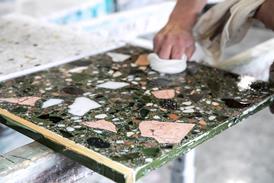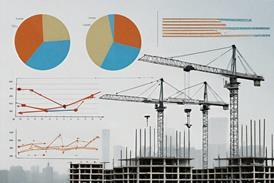This is not one of Nostradamus' predictions of an apocalyptic Millennium with London overrun by little green aliens. Far from it; this scenario has been enacted again and again on the computers at Buro Happold's Leeds office.
Here, the firm's fire and safety engineering wing (FEDRA) watches another run-through of the phased evacuation of the Dome. Those little green dots are members of the public.
The modelling program, called 'EXODUS', has been developed by the University of Greenwich working jointly with FEDRA. The software is based on a sophisticated set of sub-models that simulate people-people, people-fire and people-structure interactions.
With a diameter of 320 m, the Dome comes in way over the maximum recommended travel distance for escape. This ruled out the prescriptive route to gaining approval, instead FEDRA used EXODUS and computational fluid dynamics (cfd) modelling for a fire engineered approach.
The scale and volume created by the Dome's outer membrane enabled them to treat the exhibition spaces, core buildings and retail areas beneath the canopy as a small town sited in the open. This decision followed considerable cfx modelling of smoke, and some persuasive arguments from FEDRA.
A set of 'mini building regulations', known as the tenant's handbook, was drawn up by FEDRA for the 'town' to ensure the fire load within the Dome was kept to a minimum. This included limiting the choice of construction materials to Class O, with the option of sprinklers, using fire-rated enclosures and spacing the fire loads to form fire breaks. This was essential since the contents of the Dome were unknown at the early stages of the design process.
For people escaping the exhibition spaces and other enclosed areas, the place of safety is now the Dome enclosure and not the open air on the other side of the canopy.
Engineers anticipate that the Dome could contain a maximum of 37 000 people. With numbers this big, it is vital not to evacuate everybody on a false alarm, or for a small controlled fire. This means that evacuation of the Dome has been planned to take place in phases.
Having produced a few preliminary calculations, FEDRA was confident enough to use a spreadsheet to calculate the total evacuation time. They used the fire safety engineering principles given in DD240 and CIBSE Guide E, with which Martin Kealy, FEDRA group manager, is quite familiar – he scripted several chapters himself.
After modifying the design to take onboard the spreadsheet results, the next step for FEDRA was to undertake a detailed escape analysis using the EXODUS evacuation model.
By importing a standard cad file, the program establishes the Dome's floor plan. This plan is then flooded by thousands of little green dots, each representing a person. Each dot has its own personality ascribed by the program on a random basis. Such attributes include gender, drive, age, speed, dexterity and patience – attributes based on standard anticipated occupancy profiles.
EXODUS comprises five core interacting sub-models: occupant, movement, behaviour, toxicity and hazard. The software contains a set of 'heuristics' or rules which define the function of each sub-model. The dots shuffle around the exhibitions, clustering at some, or queuing for others, until their patience runs out and they shuffle off.
A fire is then created and evacuation commences. The personalities given to the dots mean that, as in real life, some of them head for the exit they entered by rather than the nearest fire exit. Some move fast while others move slowly, according to attributes.
The graphic image formed by the green dots allows the engineer to watch events unfold on screen. Bottlenecks are obvious. In the design of the central performance arena, it was clear from the playback that queuing was occurring around an intermediate exit. A small alteration to the geometry of the escape route reduced the overall escape times significantly.
As in a real evacuation, unpredictability means that each evacuation will be slightly different. The program has to be run a number of times for the same layout. A sensitivity analysis is performed each time to get a distribution of escape times.
A further advantage of the graphic output is that errors are easy to spot. If dots escape in the wrong direction or run around in a room, it is very apparent. Dots found to be exhibiting such individualistic characteristics can be interrogated to find the distance travelled, pre-movement times and the final escape path.
The model will be tested by evacuation drills using real people (pretending to be little green dots), before the Dome opens to the public.
Engineers at FEDRA are also using Exodus to design exhibition spaces. Nodes are created around some of the exhibits where the dots linger as if engrossed in a display. As more dots move around the exhibition, bottlenecks once again become apparent. The dots, however, appear unfazed and seek an alternative route around the space.
Groups of dots cluster around particularly interesting stands like moths drawn into the light. The dots on the outside can be seen shuffling around trying to get a better view until their patience limit is exceeded and they shuffle off in search of a less crowded exhibit.
So, green dots today, 3D textured virtual reality humans tomorrow? You can bet your life on it.
Fire safety engineering
Working with the architects Richard Rogers Partnership, Buro Happold Fire Engineering Design Risk and Assessment (FEDRA) designed the fire safety systems for the Dome shell and core, including the promenade and central performance arena. Buro Happold used its in-house computational fluid dynamics (cfd) program to assess the movement of smoke within the Dome in the event of fire. The results informed the required extract rate to keep all the evacuation routes clear of smoke. FEDRA discussed a fire strategy with Greenwich Building Control and the London Fire Brigade. Essentially the Dome was treated as a small town centre, in that the scale and volume of the enclosure, its core buildings, exhibition pavilions and retail areas are all treated in much the same way as buildings in the open. However, as the Building Regulations are rather inadequate for something as unique as the Dome, FEDRA and the local authorities collaborated to produce some “mini building regulations”. These took into account means of escape, fire load control and fire-fighting. Controlling the fire load of the Dome content also allowed the shell and core to be designed and built long before the details of the exhibitions were made available. To find the “available safe egress time”, the designers had to limit the potential fire size. This relied on a number of measures, such as restricting construction materials to Class O as much as possible. Sprinklers will probably be installed in the enclosed exhibits and the catering areas inside the core buildings. Other measures are fire-rated enclosures and fire breaks – in other words, spacing fire loads in discrete locations. Most large spaces with curved roofs do not require smoke extract systems. Certainly the vast volume of the Dome has created a smoke reservoir that would take some time to fill, and the modelling demonstrated that escape should be complete before conditions would become untenable. This was demonstrated by a fire zone model based on CIBSE Guide E. However, true to form the Dome stretched the equations in Guide E “beyond the limits of validity”. A series of comparisons were then made assuming a notional smoke reservoir that ranged from a 30° segment of the Dome to a full 360° volume. In the event of fire the roof vents will open and the extract fans will run. Both are suitably fire-rated. When comparisons were made FEDRA was satisfied that the assumption of the simple model held true “with large factors of safety”.Source
Building Sustainable Design
Reference
1The cfd package was Flows 3D from AEA Technology.
Postscript
Andrew Pearson Msc is a reporter on Building magazine.




















